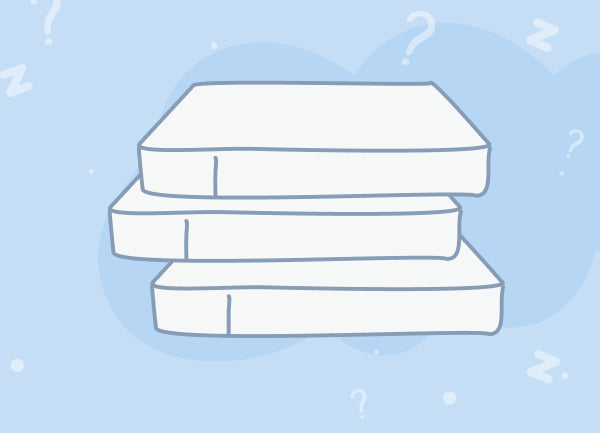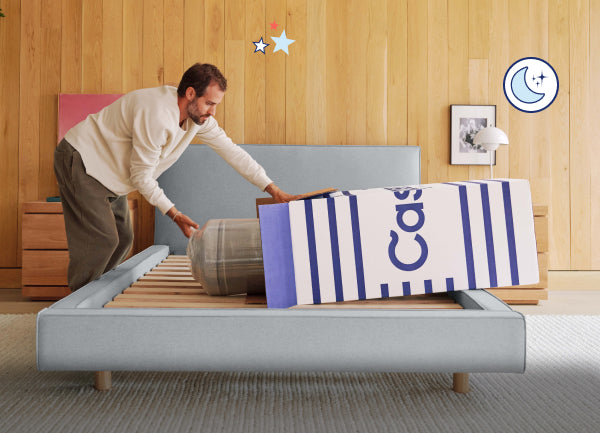It’s easy to assume that in the flannel vs. cotton sheet debate, it all comes down to two main factors: cozy and cool.
Flannel sheets — made from soft, brushed material just like your favorite plaid flannel shirt — sound invitingly warm and cozy. Perfect for the sweater weather months.
Cotton sheets, on the other hand, bring to mind smooth, cool comfort. They’re like the crisp white sheets you’d expect at a luxury hotel.
But when you’re shopping for the best sheets for your sleepytime comfort, there’s a little more to it than choosing between cozy or cool. Let’s take a deeper dive into the differences between flannel and cotton sheets.
A Tale of Two Fabrics: Flannel vs. Cotton
You may have heard the term “cotton flannel” and assumed that all flannels are also cotton. But that’s not necessarily so. Cotton sheets are always, well, cotton. But flannel isn’t always made with cotton fibers. Let’s look closer at the differences.
What Is Flannel?
Flannel is a type of fabric crafted from loosely woven fibers. Flannel sheets are often made with cotton, but they can also be made from wool, fiber blends, or synthetic fibers like polyester.
A technique called “napping” is what gives flannel its slightly fuzzy texture. After it’s woven, the fabric is brushed (on both sides or just one) to raise fine fibers. The napping process is what gives flannel its signature warmth and softness.
Although plaid patterns are usually associated with flannel clothing, flannel sheets come in a variety of solid colors and prints.
What Is Cotton?
Cotton fabric is made from natural fibers that come from the cotton plant. The fluffy white part of the cotton plant, called the “boll,” is harvested and spun into yarn. That yarn is then woven into fabric.
Cotton fabric can be anything from stiff and durable to luxuriously smooth and soft. The texture and temperature-regulating properties of cotton fabric vary depending on the type of cotton used and how it’s woven. We’ll learn more about cotton types and weaves in a moment, or you can skip ahead.

What Are Flannel Sheets?
Now that you know what flannel fabric is all about, let’s get specific: What are flannel sheets?
Unlike flannel clothing, which is often brushed on one side only (the exterior-facing one), flannel sheets are almost always brushed on both sides to make the most of the soft, plush texture that napping creates.
Although wool is used to create warm flannel clothing, it’s not typically used for sheets. Most flannel sheets are made from cotton, synthetics, or a cotton/synthetic blend. The best quality flannel sheets — those that are not only soft but also durable — are crafted from cotton.
If it’s coziness you’re looking for, high-quality flannel sheets are hard to beat. Casper’s flannel sheets are made from 100% brushed organic cotton to provide you with warmth and comfort without any synthetic fibers or chemicals.
What Are Cotton Sheets?
Not all cotton sheets are created equal. Two factors can make a big difference in your experience — the type of cotton used and the weave.
Types of Cotton
There are several different types of cotton, and knowing the difference is not just fluff — the type of cotton used to make your sheets matters.
Without getting too technical, cotton is classified by something called “staple length.” Short staple fibers are great for things like denim and flannel because they’re strong and low-maintenance. The longer the staple length, the softer and silkier the feel of the cotton.
- Upland: This common type of short-staple cotton is what most things labeled “100% cotton” are made from. It’s generally not as soft as other cotton types.
- Pima: Supima® is an American Pima cotton. It features a long-staple that’s splendidly soft and durable, but also affordable.
- Egyptian: If it’s luxury you’re after, Egyptian cotton is the smoothest, softest, most durable type, with an extra-long staple. Expect to spend more for the real deal.
Types of Cotton Weaves
The quality of the cotton your sheets are made from are important, but so is the weave. It affects the texture, sturdiness, and softness. Here are a few of the most common weaves for sheets:
- Percale: Percale sheets are made with a plain weave — one yarn over, one under. The finish is smooth and crisp. Percale is best suited for warm weather or hot sleepers.
- Sateen: Don’t confuse sateen sheets with satin — they’re similar, but satin has a shinier, silkier texture than sateen. This smooth, luxurious weave creates a warmer fabric that’s best for cool weather and cold sleepers.
- Twill: Twill’s over two, under two weave pattern creates its distinctive diagonal design. Although twill sheets are typically wrinkle-resistant and affordable, they’re more prone to shrinking than those made with other weaves.
Flannel vs. Cotton Sheets Comparison
| Quality | Flannel | Cotton |
| Warmth | Fluffy texture holds in warmth | Smooth texture feels cooler and warms slowly |
| Cooling | Napped texture traps body heat | Breathable fabric releases body heat |
| Durability | Generally considered durable | Generally considered durable |
| Breathability | Breathable, but texture traps warmth | Breathable |
Warmth
If you tend to feel cold when you crawl into bed at the end of a long day, warm sheets may be just the thing to help you feel comfy and ready for a good night’s rest.
Because of the napping process, flannel sheets have a fluffier texture that gives them a feeling of instant warmth. Cotton sheets, on the other hand, usually have a smoother texture that feels cool to the touch and warms slowly in response to your body heat.
Winner: Flannel
Cooling
We get it: Some like it warm, others like it cool. And there’s no doubt that slipping between cotton sheets can be a deliciously cooling experience.
Cotton tends to be breathable — air flows through it easily. Breathable fabrics keep you cooler by preventing warm air — like the kind you generate with your own body heat — from becoming trapped between your skin and the fabric.
Even though flannel sheets are often made of cotton, the napped texture of flannel can make it feel warmer because flannel’s insulating air pockets trap heat.
Winner: Cotton
Durability
Both flannel and cotton sheets can be quite durable. It all depends on how they’re made. Here are a couple of things to consider:
Cotton thread count
Thread count measures the number of fibers per square inch of fabric. With cotton, a higher thread count (which means the fabric is more tightly woven) may increase durability.
But there’s one caveat: A higher thread count doesn’t always mean higher quality. As we just learned, the weave and type of cotton used also factor in.
Flannel weight
The quality of flannel is measured by weight in ounces per square yard rather than thread count. Flannel in the five- to six-ounce range is considered good quality.
Winner: Tie
Breathability
Both cotton and flannel are breathable. But the napping process responsible for flannel’s fuzzy texture also traps warm air. So although flannel is more loosely woven than cotton, it’s also naturally warmer.
Choose flannel when you want to retain warmth while you snooze and cotton if you want to sleep cooler.
Winner: Cotton
Flannel vs. Cotton: Care FAQs

Now that you’ve got the scoop on flannel vs. cotton sheets, let’s answer a few of the most common questions about caring for them.
Do flannel sheets require different care from cotton sheets?
Although you may find an exception here and there (always read the care instructions label!), flannel and cotton sheets require similar care. As a rule, just machine wash and dry them regularly, and make sure to fold them when they’re not on your bed.
How should I wash my cotton or flannel sheets?
Caring for both cotton and flannel sheets is simple. As a rule, wash your sheets on the warmest setting the care label allows for. Warm water helps to remove germs and dust mites. You can take extra steps like whitening your sheets occasionally as needed.
How often should I wash my cotton or flannel sheets?
OK, we don’t want to gross you out, but here’s a not-so-fun fact: Humans produce about 26 gallons of sweat in bed every year. Fungus grows well in warm, moist environments. We also shed skin cells, hair, and dander. We use lotions and other products that leave a residue.
There’s more, but because we want you to actually sleep well, we’ll cut to the chase: Good hygiene dictates that you should wash your sheets about once a week.
Do I have to use a top sheet?
We conducted a survey and learned that younger people are less likely to sleep with a top sheet. And hey, no judgment!
But remember that 26 gallons of sweat we just mentioned? Unless you want to wash your bulky comforter as often as you wash your sheets, a top sheet can help to promote cleaner bedding and a healthier sleep environment.
If you’re truly committed to a life without top sheets, consider a duvet. Duvets have a removable cover that slips over an insert much like a pillow case slips over a pillow. You’ll be able to wash the duvet cover on the regular without having to wash the insert as often.
How can I prevent wrinkling?
High-quality sheets are manufactured to be wrinkle-resistant. But there are still some things you can do to avoid either having to iron or waking up with weird creases embossed on your skin.
First, always wash your sheets by themselves. Don’t overload your washer or dryer. Second, move your sheets from the washer to the dryer as soon as the cycle is finished. And finally, take them out of the dryer promptly and fold them (unless they’re going directly onto your bed).
Quality Sheets Make for Better Sleep
Shakespeare said that sleep “knits up the raveled sleave of care.” Consider your sheets an investment in enhancing this essential and restorative ritual.
Whether it’s cool comfort (cotton) or cozy warmth (flannel) you’re after, Casper’s luxurious sheets are the perfect complement for restful slumber.













